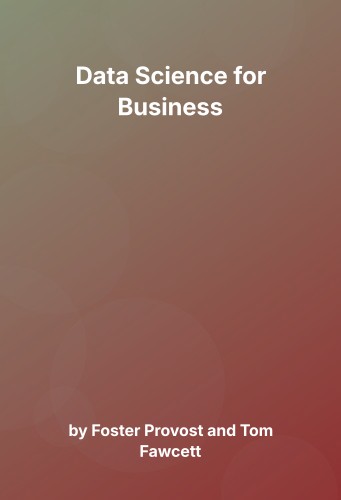Summary
Data Science for Business by Foster Provost and Tom Fawcett provides a comprehensive, accessible introduction to data science fundamentals, tailored for business professionals and decision-makers. Rather than focusing on tools or code, it emphasizes the reasoning and principles behind data-driven decision-making. It bridges the gap between data science and business strategy, empowering readers to understand how to derive value from data.
What is Data Science?
The book defines data science as the extraction of useful knowledge from data to solve business problems. It goes beyond mere statistics or IT—it involves:
- Understanding business objectives
- Translating problems into data questions
- Using analytical methods to extract insights
- Implementing solutions that influence decisions
Data science is iterative, experimental, and fundamentally interdisciplinary.
The Data Mining Process
A core concept is the data mining process framework, which includes the following stages:
- Business understanding – Define goals and success criteria.
- Data understanding – Assess data sources and explore patterns.
- Data preparation – Clean, transform, and select relevant data.
- Modeling – Apply algorithms to create predictive or descriptive models.
- Evaluation – Interpret models in the business context.
- Deployment – Integrate the results into decision-making processes.
This cycle is at the heart of applied data science in business.
Key Analytical Methods
The book explores a wide array of techniques, providing intuitive explanations without excessive math.
1. Classification
Classification involves predicting a categorical label (e.g., churn/no churn). Common algorithms include:
- Decision trees
- Logistic regression
- Support vector machines
- Naive Bayes classifiers
Classification is used for fraud detection, customer segmentation, and risk assessment.
2. Regression
Regression predicts numeric values, such as sales forecasts or pricing models. Techniques like linear regression and regularized models help understand variable relationships.
3. Clustering
Clustering discovers groups or patterns in data without predefined labels. It’s useful for market segmentation, product recommendation, or anomaly detection.
4. Similarity Matching
Matching items or people based on similarity metrics is used in recommender systems and targeted marketing.
5. Co-Occurrence Grouping
Also known as association rule mining, this identifies items frequently appearing together (e.g., “people who buy X also buy Y”).
6. Profiling and Anomaly Detection
Profiling builds a typical model of behavior, while anomaly detection flags outliers (e.g., fraudulent transactions).
Evaluating Model Performance
Provost and Fawcett emphasize that evaluating a model’s success depends on context:
- Accuracy, precision, recall, and F1 score for classification
- Root mean square error (RMSE) for regression
- ROC curves and AUC (Area Under Curve) for comparison
Crucially, these metrics must be aligned with business objectives. A 95% accurate model might be useless if it misses the rare, high-risk cases (e.g., fraud).
Overfitting and Generalization
A core risk in data science is overfitting—when a model performs well on training data but poorly on unseen data. This occurs when models are too complex or tuned to noise.
Solutions include:
- Cross-validation
- Regularization
- Simpler models with better interpretability
The goal is to build models that generalize well to new data.
Data-Driven Decision-Making
The book introduces the expected value framework to support rational decision-making:
- Estimate the value of different actions based on model predictions.
- Use probabilities to account for uncertainty.
- Quantify the cost-benefit tradeoffs (e.g., false positives vs. false negatives).
This framework links data science outputs directly to ROI.
Role of Business Expertise
Data science isn’t a purely technical field—it relies on domain knowledge:
- Choosing relevant variables
- Interpreting patterns meaningfully
- Setting realistic evaluation benchmarks
The most successful data science projects involve close collaboration between analysts and business stakeholders.
The Data Science Team
Provost and Fawcett describe roles on a modern data science team:
- Data scientists: technical modeling and analysis
- Data engineers: infrastructure and pipelines
- Domain experts: business context
- Decision-makers: deployment and integration
Successful teams foster communication, experimentation, and mutual learning.
Data as a Strategic Asset
The authors argue that data is not simply an IT byproduct—it’s a competitive differentiator. Firms like Amazon, Netflix, and Google thrive because they:
- Collect meaningful data at scale
- Use it to personalize and optimize
- Make data-driven decisions core to their operations
Companies should treat data as a strategic asset—collected purposefully, managed well, and leveraged for insight.
Ethics and Privacy
The book addresses ethical concerns including:
- Data privacy
- Algorithmic bias
- Transparency and explainability
It warns that blindly applying models can cause unintended harm, particularly in sensitive domains like credit scoring or hiring.
Ethics must be integrated into every step of the data science pipeline.
Common Pitfalls
- Misunderstanding correlation vs. causation
- Blind trust in model outputs
- Ignoring data quality
- Misalignment between model metrics and business goals
The authors repeatedly stress that data science is about asking the right questions, not just running algorithms.
Key Takeaways
- Data science is a disciplined process of turning data into actionable insight.
- Success depends on understanding the business context and formulating meaningful problems.
- Models are tools for supporting—not replacing—human judgment.
- Good data science requires iteration, testing, and continuous learning.
- Ethical use of data is essential to long-term success and trust.
Why This Book Matters
Data Science for Business is one of the most respected introductions to data science for non-specialists. It distills complex topics into understandable concepts and aligns them with business thinking.
Whether you’re a manager working with data teams, a student learning the fundamentals, or a technical professional trying to improve communication with executives, this book provides the foundation to think like a data scientist.
TL;DR
Data Science for Business explains how to use data to make better decisions. It teaches the logic behind data mining, modeling, and evaluation—grounding data science in business strategy, ethics, and value creation.

